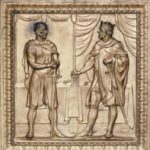Tension between the states and the federal government has been a constant throughout U.S. history. This video explores the supremacy clause in Article VI of the Constitution and key moments in the power struggle, including the landmark case McCulloch v. Maryland. In McCulloch, Chief Justice John Marshall wrote that the supremacy clause unequivocally states that the “Constitution, and the Laws of the United States … shall be the supreme Law of the Land.”
Magna Carta: Cornerstone of the U.S. Constitution

Magna Carta served to lay the foundation for later declarations of rights in England and the United States. In attempting to establish checks on the king’s powers, this document asserted the right of “due process” of law. It also provided the basis for an idea of a “higher law,” one that could not be altered either by executive mandate or legislative acts. This concept, embraced by the leaders of the American Revolution, is embedded in the supremacy clause of the United States Constitution.
Constitutional Index – Supremacy Clause
The Constitutional Index breaks down the U.S. Constitution by Section, Amendment, and Clause and contains broader topics and themes. These are used to cross-reference Library resources in an effort to annotate constitutional history.
The Constitutional Convention
In this lesson, students will use C-SPAN video clips to examine the founding principles that emerged from the Constitutional Convention as well as hear about some of the people who participated. Students will use this information to analyze the role the compromise played in the creation of the Constitution.
Chamber of Commerce v. Whiting (2011)
Is the Legal Arizona Workers Act invalid under the Immigration Reform and Control Act? This case summary shows how the Supreme Court answered that question in 2011.
Freedom Summer
In the summer of 1964, student volunteers from around the country joined organizers and local African Americans in a historic effort to shatter the foundations of white supremacy in Mississippi, one of the nation’s most segregated states . The website features historical background essays, bonus video of interviews with participants and original art work.